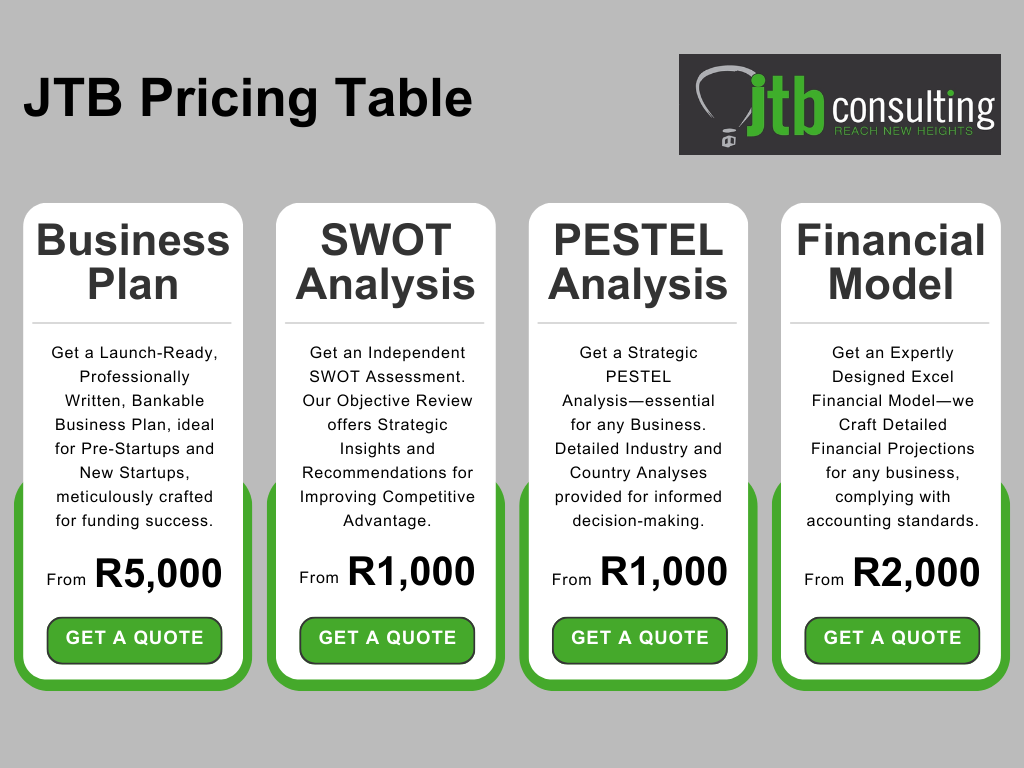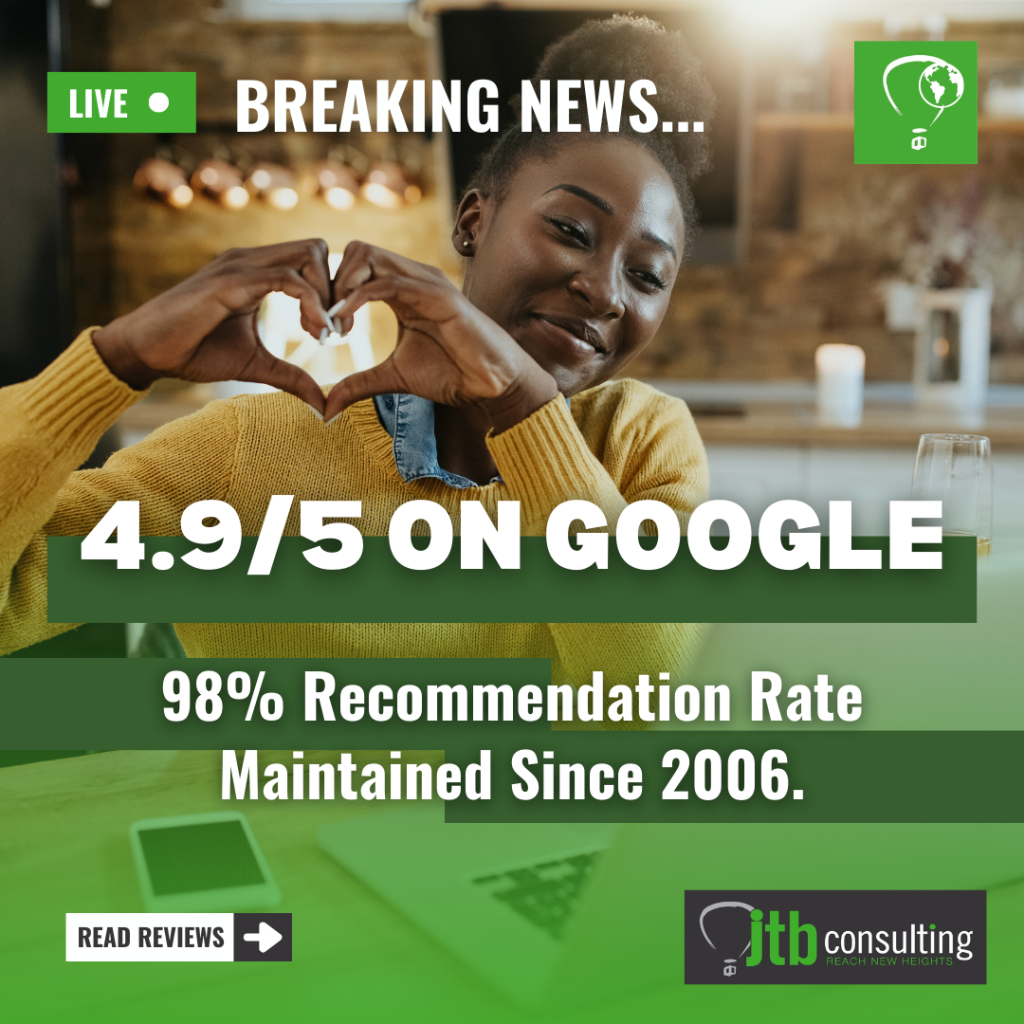Every business owner should conduct a regular SWOT Analysis to assess the company’s strengths, weaknesses, opportunities, and threats to its competition.
In 2014, Dr. Thommie Burger, Founder of JTB Consulting, designed a unique SWOT Analysis Tool as part of his Ph.D. Dissertation on “Entrepreneurship and the importance of Internal and External Analysis of Startups.” Whether you have a startup business or already manage an existing business, conducting a SWOT Analysis is an integral part of your planning. This is where JTB Consulting can help.

SWOT Analysis 101
A SWOT Analysis helps evaluate where a company stands in a competitive market and what steps need to be taken for further strategic planning, assisting decision-makers to draw a future roadmap for the company. The importance (and advantages) of conducting a SWOT analysis can be summarised as follows:
- A SWOT Analysis helps organisations understand their current status and measure overall business performance.
- A SWOT Analysis lets a business analyse its strengths, which can help it better penetrate the Market and meet its targets.
- A SWOT Analysis allows organisations to see their weaknesses and potential areas for improvement. This information helps them plan for and mitigate future roadblocks, ensuring the business’s long-term growth.
- By leveraging its SWOT Analysis, a business can create a strategic plan to meet desired objectives and adapt to changing market conditions.
- A SWOT Analysis lets businesses understand and better identify internal and external factors and their positive and negative impacts on the business. This information can help businesses be more proactive by helping them take appropriate actions in a dynamic market to maintain momentum.
Small business owners must create products and services the customer values and produce and deliver them in exceptional ways compared to the competition. To meet this challenge, a company must define its current business, operational objectives, and goals while considering factors that impact them.
Companies engage in structured brainstorming, which can be supported by a Strengths, Weaknesses, Opportunities and Threats (SWOT) analysis. The SWOT methodology has advantages, such as its use to address various business issues, making it a desirable tool to support some brainstorming sessions. However, the tool’s disadvantages, such as the subjective analysis of an issue, make it less desirable for others.

SWOT analysis has been used for decades and gives you a systematic way of analysing the Market. Combined with other analysis tools, such as PESTLE, it can greatly reduce the risk of missing something important. There are so many things to consider that it’s easy to miss crucial things if you are not careful.
In conclusion, SWOT Analysis is an important tool for understanding an organisation’s health. It allows decision-makers to identify where an organisation stands and where it needs to improve. This allows them to be proactive players in the Market while helping them remain competitive.
Use the following free Checklist to start your SWOT Analysis.
JTB Consulting’s SWOT Analysis Checklist for 2024
The “S” in SWOT Analysis — Strengths (Internal, Positive Attributes of Your Business)
Marketing
- What is my company’s competitive advantage?
- What is our unique selling proposition?
- Do we have exclusive relationships with suppliers or distributors?
- How extensive is our distribution network?
- What are the strengths of our marketing and sales team?
- Do we have a well-known brand?
- Do we have any off-take customers and/or early sales?
Human Resources
- Do our employees have skills or expertise that our competitors’ employees lack?
- Do our employees have professional accreditations or certifications that give us an advantage?

Assets
- Do we have proprietary technology, intellectual property, or other valuable information?
- Do we have a prototype or proof of concept tested in the Market? Alternatively, have we implemented our idea on a Pilot Project Basis to test market/customer acceptance?
- Do we have equipment or machinery that our competitors don’t?
- Does our location or building give us a competitive advantage?
Financial Resources
- How well capitalised is the business?
- Can we easily access additional capital if needed?
- Do the business’s profit margins and other financial indicators compare favourably to industry benchmarks?
Need Some Guidance? Faced with Business Failure? 5 Critical Things to Consider Before You Close Shop!

The “W” in SWOT Analysis — Weaknesses (Internal, Negative Attributes Of Your Business)
Marketing
- What complaints do we frequently hear from customers?
- What objections do we frequently hear from prospects?
- Is the business’s distribution limited?
Assets
- Does the business’s location or physical plant have any weaknesses?
- Are the business’s technology, equipment and machinery outdated?
Human Resources
- Is the business adequately staffed?
- Do employees lack the skills or expertise needed to compete?
Financial Resources
- Does the business suffer from cash flow problems?
- Are the business’s profit margins and other financial indicators poor compared to competitors?
- Does the business have excessive debt?
- Would the business have difficulty accessing additional capital?
Read More: 10 Reasons Your Business Plan Is Not Funded
The “O” in SWOT Analysis — Opportunities (External, Positive Factors That Could Help The Business)
Competitive Environment
- Do competitors have any weaknesses from which the business could benefit?
Market Environment
- Is the target market changing in ways that could benefit the business?
- Is there a potential niche market the business is currently ignoring?
- Is there something clients and customers are asking for that the business doesn’t provide but could add?
- Are there upcoming local, regional or national events that could present opportunities for the business?
- What opportunities for geographic expansion exist?
Economic Environment
- How might current and projected economic trends present opportunities for the business? (i.e., housing prices, employment rates, consumer confidence)
- What changes are taking place in the industry that could create opportunity?
- Are there potential new sources of financing that could help the business?
- Could projected changes in interest rates, tax laws, or banking regulations benefit the business?
Political Environment
- How might proposed changes to local, provincial, national, regional, or neighbouring government positively affect the business?
Technological Environment
How could predicted technological advances create opportunity for the business?
In Case You Missed It: Be the Next Successful Startup Business in 2022
The “T” in SWOT Analysis — Threats (External, Negative Factors That Could Hurt The Business)
Competitive Environment
- Are our competitors planning expansion, new product or service launches, or other changes that could hurt our business?
- Are there businesses that aren’t currently direct competitors but could be in the future?
Market Environment
- Is our target market shrinking?
- Could predicted social changes negatively impact demand for our product?
- Does the business rely too heavily on one big customer?
Economic Environment
- How might current and projected economic trends (i.e., housing prices, employment rates, consumer confidence) negatively impact the business?
- What predicted industry trends could hurt the business?
- Could changes to external financial factors, such as revised lending standards, increased cost of capital or higher interest rates, hurt the business?
- Are there projected increases to the cost of doing business (i.e., rent, wages, inventory, utilities) that could hurt the company?
Political Environment
- Could local, state and national governmental changes, such as regulatory restrictions or new trade agreements, negatively affect the business?
Technological Environment
- How might predicted technological advances negatively affect the business?
Something Extra!
Have you ever wondered what some of the Pros and Cons are of the SWOT Analysis? See our list below:
Advantage: Problem Domain
SWOT analysis can be applied to an organisation, organisational unit, individual, or team and can support several project objectives. For example, the SWOT method can evaluate a product or brand, acquire or partner, or outsource a business function. It can also be beneficial in assessing a particular supply source, a business process, a product market, or the implementation of a specific technology.
Advantage: Application Neutrality
SWOT analysis is conducted by specifying an objective and conducting a brainstorming session to identify internal and external factors that favour or hinder the objective’s achievement. This approach remains the same whether the analysis supports strategic planning, opportunity analysis, competitive analysis, business development, or product development processes.
Advantage: Multi-Level Analysis
You can gain valuable information about your objective’s chances by viewing each of the four elements of the SWOT analysis – strengths, weaknesses, opportunities and threats – independently or in combination. For example, identified threats in the business environment, such as new government regulations regarding a product design or the introduction of competing products, might alert the business owner that a proposed investment in a new manufacturing production line should be more carefully evaluated.
In addition, an awareness of a company’s weakness, such as a lack of qualified employees, might suggest a need to consider outsourcing particular functions. In turn, opportunities such as the availability of low-interest loans for startups might encourage the entrepreneur to develop a new product to meet rising customer demand. In contrast, identified strengths, such as extensive experience in an industry experiencing rapid international growth, might suggest the need to partner with foreign companies.
Advantage: Data Integration
A SWOT analysis requires combining quantitative and qualitative information from several sources. Access to a range of data from multiple sources improves enterprise-level planning and policy-making, enhances decision-making, improves communication, and helps coordinate operations.
Advantage: Simplicity
A SWOT analysis requires neither technical skills nor training. Instead, it can be performed by anyone with knowledge about the business in question and the industry in which it operates. The process involves a facilitated brainstorming session during which the four dimensions of the SWOT analysis are discussed. As a result, individual participants’ beliefs and judgments are aggregated into collective judgments endorsed by the group. In this way, each individual’s knowledge becomes the group’s knowledge.
Advantage: Cost
Because SWOT analysis of business requires neither technical skills nor training, a company can select a staff member to conduct the study rather than hire an external consultant. In addition, SWOT is a somewhat simple method that can be performed in a reasonably short time.
Disadvantage: No Weighting Factors
SWOT analysis for a business plan leads to four individual lists of strengths, weaknesses, opportunities and threats. However, the tool provides no mechanism to rank the significance of one factor versus another within any list. As a result, it’s difficult to determine the amount of any one factor’s true impact on the objective.
Disadvantage: Ambiguity
SWOT analysis for a business creates a one-dimensional model which categorises each problem attribute as a strength, weakness, opportunity or threat. As a result, each attribute appears to have only one influence on the analysed issue. However, one factor might be both a strength and a weakness. For example, locating a chain of stores on well-travelled streets that grant easy access to customers might be reflected in increased sales. However, the costs of operating high-visibility facilities can make competing on price without a large sales volume difficult.
Disadvantage: Subjective Analysis
Business decisions must be based on reliable, relevant, and comparable data to impact company performance significantly. However, SWOT data collection and analysis entail a subjective process that reflects the bias of the individuals who collect the data and participate in the brainstorming session. In addition, the data input to the SWOT analysis can quickly become outdated.
Read More: Your Business Model and 15 Unique and Proven Examples for Your Startup.







